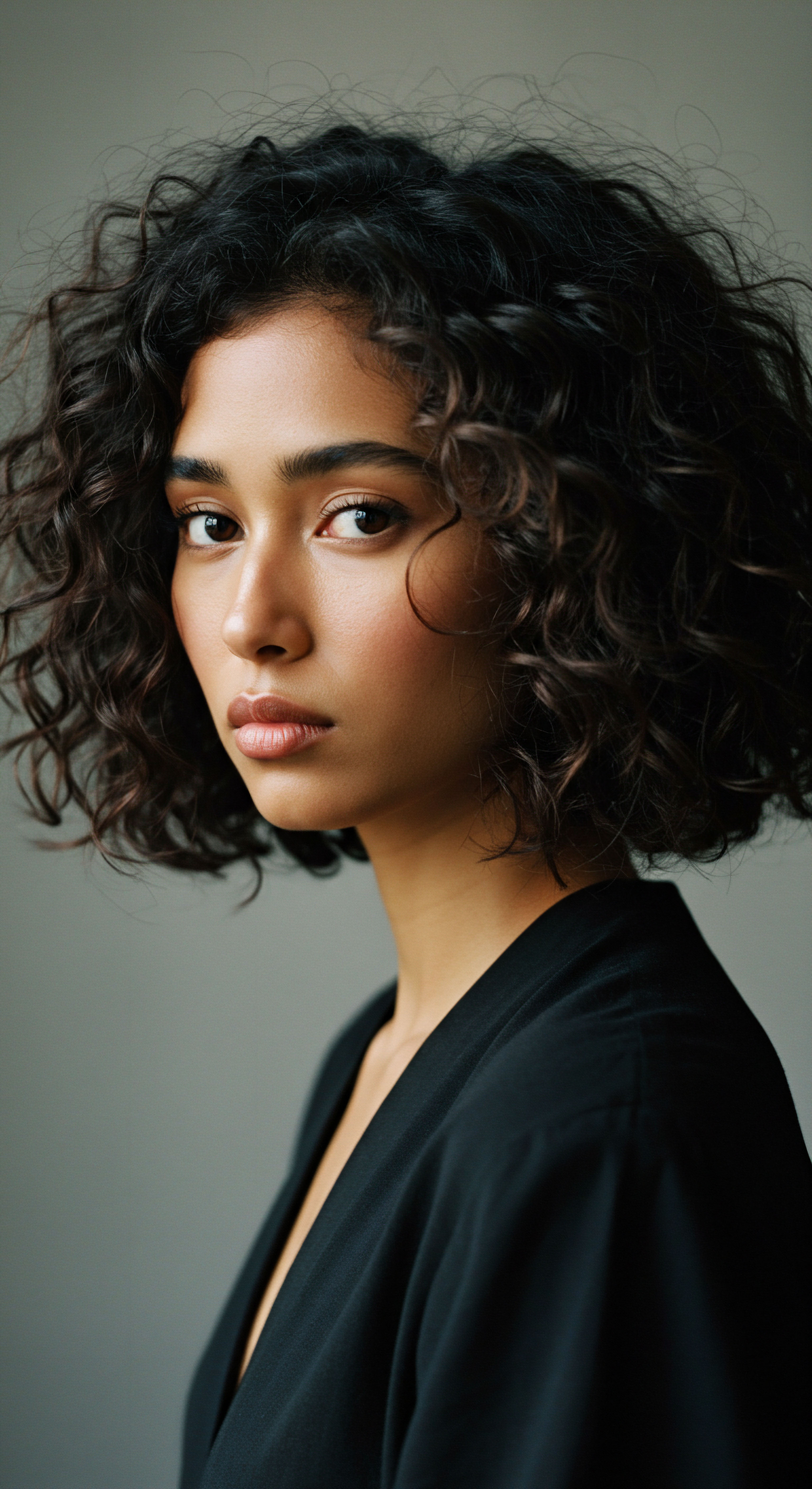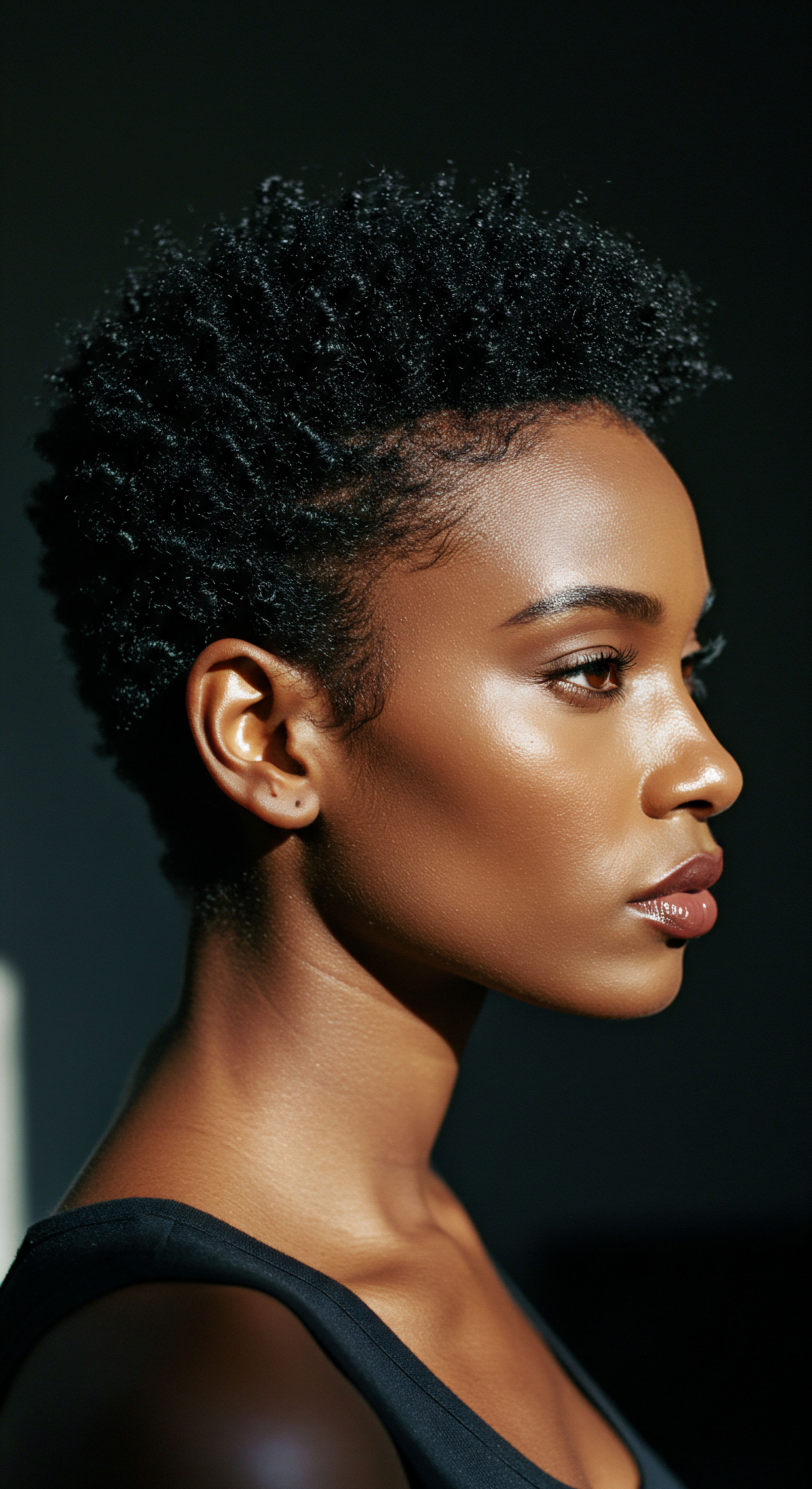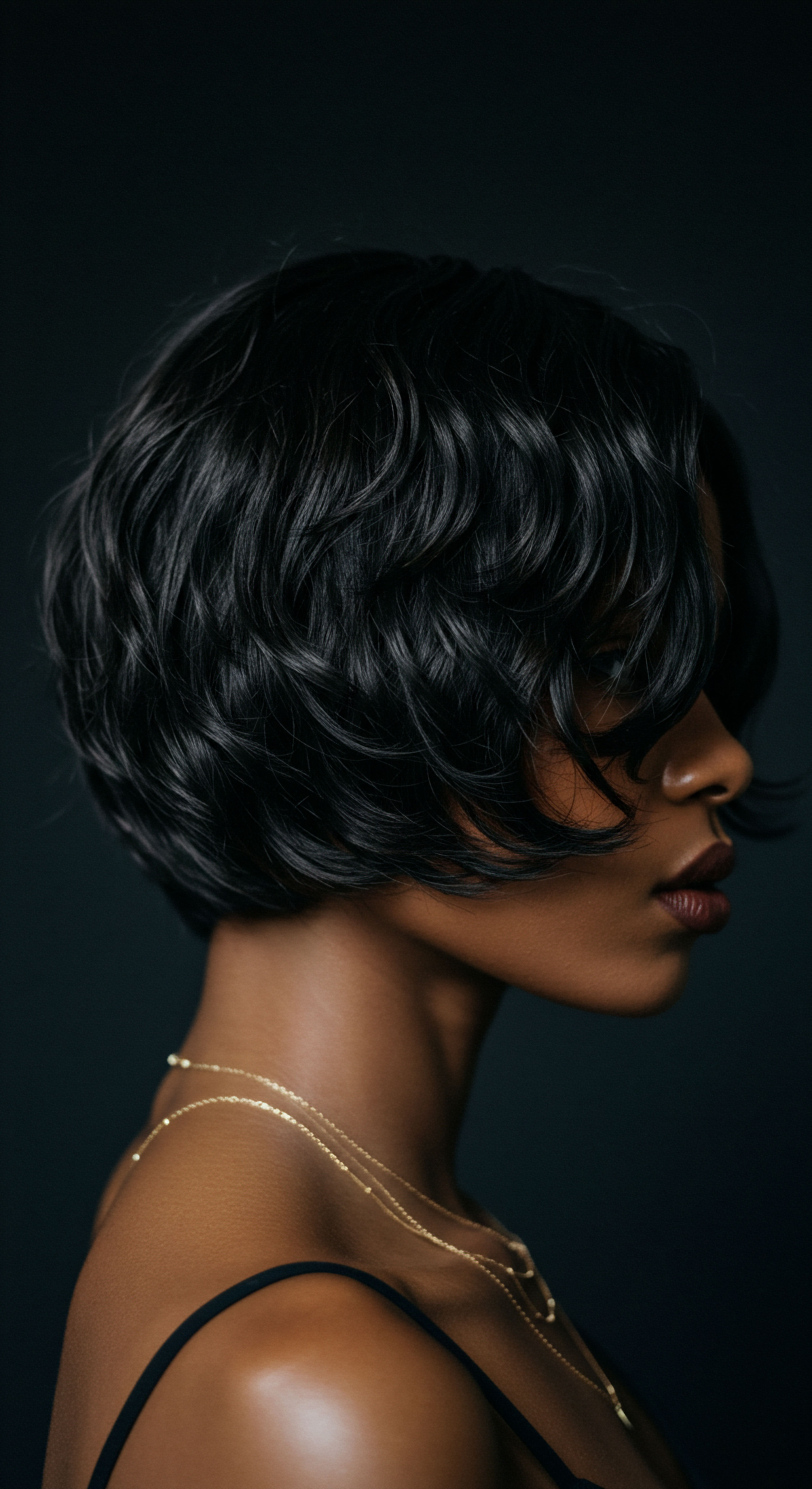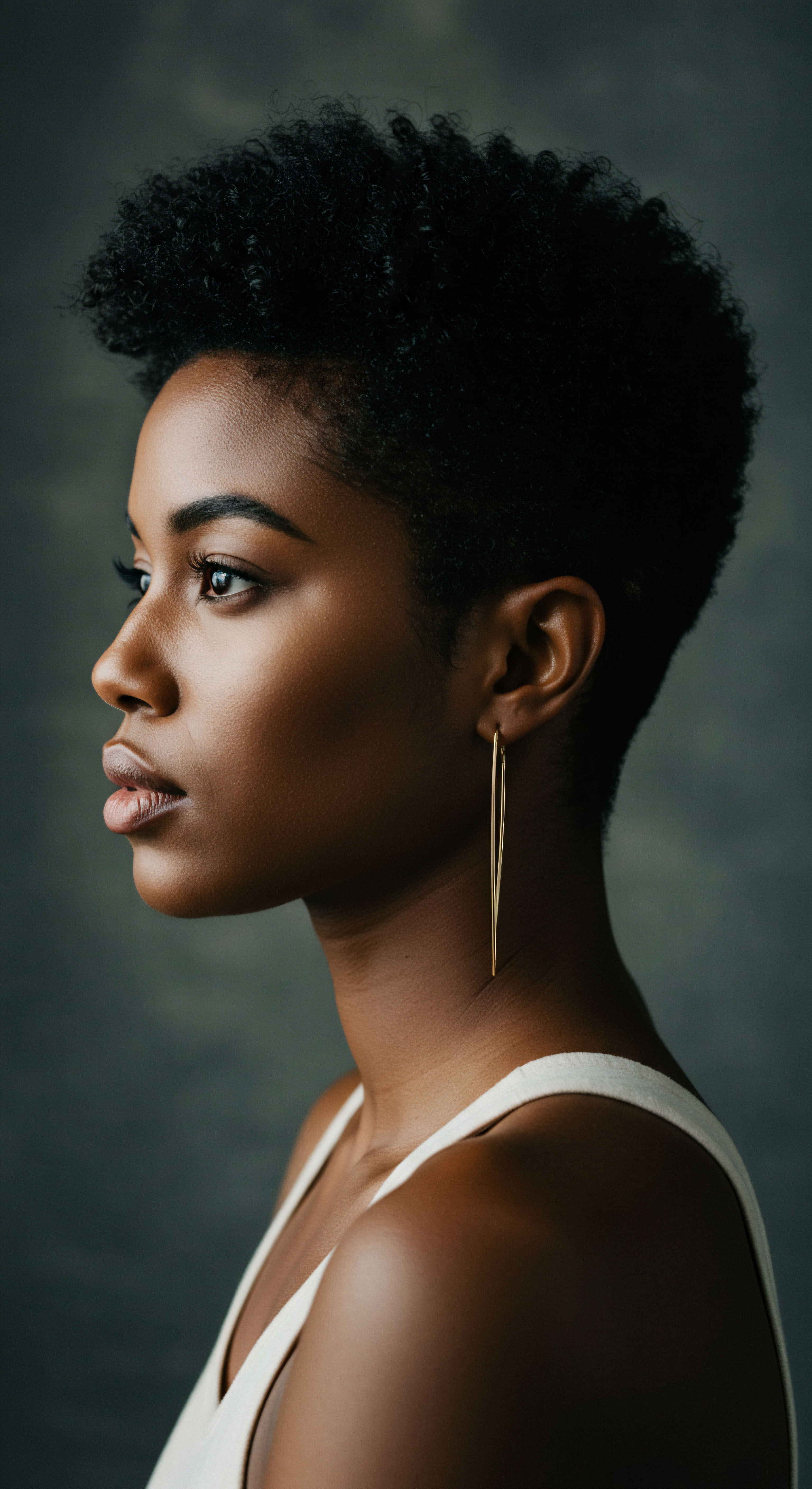
Roots
The whisper of generations past often finds its way into the present, particularly when we consider something as personal as our hair. It holds stories, not just of styling preferences or daily routines, but of deep cultural meaning and resilience. For those with textured hair, this connection runs especially true. Our hair, with its unique patterns and varying needs, is a living record of heritage, carrying within its very structure echoes of ancestral landscapes and practices.
To understand hair porosity today, to truly grasp its implications for product choices, one might first turn to the wisdom that existed long before laboratories and ingredient lists became commonplace. This wisdom, passed down through families and communities, recognized hair as an extension of self, deserving of thoughtful, natural care.

What Does Hair Porosity Truly Signify?
At its core, hair porosity describes how readily your hair absorbs and holds onto moisture. Consider the outer layer of a single hair strand, the cuticle. This protective sheath consists of overlapping scales, much like shingles on a roof. When these scales lie flat and close together, moisture finds it challenging to enter, resulting in what is termed Low Porosity.
Conversely, if these scales are lifted or widely spaced, hair can absorb water quickly, but also loses it just as rapidly, a characteristic of High Porosity. Hair that balances absorption and retention sits in the middle, exhibiting normal porosity. This understanding is foundational, a starting point for any personalized hair care journey.
However, this scientific definition only tells part of the story. For many, particularly those with Afro-textured hair, the concept of porosity carries a deeper, almost inherited weight. Research indicates that the unique helical structure of Afro-textured hair, with its natural twists and bends, can inherently lead to cuticle lifting at various points along the fiber, potentially contributing to higher porosity. This is not a flaw, but a natural characteristic, a testament to the diverse expressions of human hair.
For instance, studies have shown that African hair exhibits the lowest radial swelling percentage in water due to its high apolar lipid levels compared to Asian and European hair, yet paradoxically, it can also possess increased permeability to treatments. This seeming contradiction highlights the need to look beyond simplistic categorizations and embrace the complex reality of textured hair.
Hair porosity, a measure of moisture absorption and retention, reflects the cuticle’s state and is deeply influenced by hair’s inherent structure and heritage.

Ancestral Echoes in Hair Structure
Long before the term “porosity” entered our vocabulary, ancient civilizations intuitively understood how different hair types interacted with their environment and natural resources. They observed, adapted, and formulated. In Ancient Egypt, where the harsh desert climate presented significant challenges, castor oil and almond oil were valued for their moisturizing and protective qualities, shielding hair from environmental aggressors. These early formulators, without microscopes or chemical analyses, were, in essence, addressing hair’s moisture needs based on its observable behavior – a practical, ancestral understanding of what we now call porosity.
The unique properties of Afro-textured hair, for example, have long necessitated specific care. Its tight curl patterns, while beautiful, naturally hinder the easy travel of sebum, the scalp’s natural moisturizer, along the hair shaft. This characteristic makes it more prone to dryness, breakage, and knotting compared to straighter hair types.
Ancestral practices, therefore, developed around these inherent needs, focusing on methods and ingredients that prioritized deep hydration and protection. These traditions, passed down through generations, are not merely folklore; they represent a rich repository of empirical knowledge.
Consider the subtle wisdom embedded in practices that utilized plant-based oils and butters, or the strategic use of protective styles. These were not random acts; they were responses to the hair’s intrinsic qualities, a recognition of its delicate balance with its surroundings. The historical use of natural emollients, herbs, and roots in hair care, from Ayurvedic traditions using Amla and Shikakai to Native American tribes using yucca root for cleansing, demonstrates a profound, long-standing connection to hair health that predates modern science.

Ritual
Stepping from the foundational understanding of hair’s intrinsic nature, we arrive at the realm of ritual – the daily and periodic practices that breathe life into our hair care. This is where ancestral understanding truly begins to reshape current product choices, transforming routine into a mindful, purposeful engagement with our strands. It calls for a re-evaluation of what we apply, how we apply it, and the very rhythm of our care, moving beyond mere surface solutions to a deeper connection with our hair’s inherent needs. The gentle guidance of past generations, rooted in observation and responsiveness, provides a compelling blueprint for today’s choices.

How Do Ancestral Practices Inform Product Application?
Ancestral hair care often centered on nourishment and preservation, favoring ingredients that worked in harmony with the hair’s natural state. This often meant the use of plant-based oils, butters, and natural cleansers. For instance, the use of shea butter, rich in fatty acids, or various plant oils like coconut and olive oil, historically provided a protective layer and moisture to the hair, mimicking or augmenting the hair’s natural lipid content.
These practices, in essence, were addressing porosity without the scientific nomenclature. They intuitively understood that certain hair types required specific lipids and humectants to maintain their suppleness and strength.
Modern science now provides a lens through which to appreciate this ancient wisdom. A study published in the Journal of Cosmetic Dermatology in 2019 highlighted that high porosity hair in African American women often stems from a compromised cuticle layer, leading to 30% more breakage and 40% less moisture retention compared to hair with normal porosity. This finding reinforces the ancestral emphasis on ingredients that seal and protect, offering a scientific validation for practices that have long been intuitively applied. The ancestral ritual of consistent oiling or buttering, for example, directly counters the rapid moisture loss characteristic of high porosity hair.
Ancestral hair care rituals, though lacking modern terminology, effectively addressed hair porosity by prioritizing nourishing, protective ingredients and methods.

Beyond the Label ❉ Ingredients Through an Ancestral Lens
The modern marketplace presents an overwhelming array of products, each promising solutions. However, when viewed through an ancestral lens, product selection becomes less about trending ingredients and more about fundamental compatibility with hair’s porosity. For high porosity hair, which struggles to retain moisture, ancestral wisdom points to heavier oils and butters that act as sealants. For hair that resists moisture entry, lighter, penetrating oils and humectants were often favored, often in conjunction with warmth or steam to aid absorption.
- Botanical Oils ❉ Consider the traditional use of Castor Oil in African and Caribbean communities for its dense, coating properties, or Jojoba Oil, which closely resembles the scalp’s natural sebum. These choices reflect an intuitive understanding of lipid composition and its interaction with hair’s outer layer.
- Herbal Infusions ❉ Many cultures used Rosemary, Sage, or Chamomile infusions, not only for cleansing but also for their toning and cuticle-smoothing effects. These preparations, often acidic, could help to gently close the cuticle, benefiting hair prone to moisture loss.
- Clays and Natural Cleansers ❉ Rhassoul clay, for instance, has been used for centuries as a gentle cleanser that removes impurities without stripping the hair’s natural oils, preserving its delicate moisture balance.
The table below illustrates a comparative view of ancestral ingredients and their potential benefits related to porosity, juxtaposed with their modern counterparts.
| Ancestral Ingredient/Practice Shea Butter, Cocoa Butter |
| Traditional Application/Benefit Rich emollients, protective barrier, moisture seal |
| Porosity Implication (Ancestral Understanding) High porosity (sealing moisture in) |
| Modern Product Equivalent/Ingredient Heavy creams, hair butters, lipid-rich conditioners |
| Ancestral Ingredient/Practice Olive Oil, Coconut Oil |
| Traditional Application/Benefit Penetrating oils, conditioning, strength |
| Porosity Implication (Ancestral Understanding) All porosities (conditioning, protecting) |
| Modern Product Equivalent/Ingredient Pre-poo treatments, deep conditioners with fatty acids |
| Ancestral Ingredient/Practice Herbal Rinses (e.g. Apple Cider Vinegar, Hibiscus) |
| Traditional Application/Benefit Cleansing, pH balancing, cuticle smoothing |
| Porosity Implication (Ancestral Understanding) High porosity (closing cuticles), low porosity (clarifying) |
| Modern Product Equivalent/Ingredient Acidic rinses, pH-balanced shampoos/conditioners |
| Ancestral Ingredient/Practice Steaming (over herbal concoctions) |
| Traditional Application/Benefit Opening cuticles for deeper penetration |
| Porosity Implication (Ancestral Understanding) Low porosity (aiding absorption) |
| Modern Product Equivalent/Ingredient Hair steamers, warm deep conditioning treatments |
The consistent use of these elements, often combined with gentle detangling and protective styling, formed a comprehensive ritual. This approach was not prescriptive in the modern sense, but adaptive, responding to the hair’s felt needs, which, at their heart, were about managing its porosity.

Relay
The conversation surrounding hair porosity deepens considerably when we move from personal experience and ritual into the scientific underpinnings and broader cultural currents. How does the inherited blueprint of our hair interact with the environmental and chemical forces of contemporary life, and what does this mean for truly effective product choices? This segment aims to illuminate the complex interplay, drawing upon scientific findings and cultural perspectives to paint a more complete picture of hair porosity and its profound implications. We will explore how understanding hair’s inherent characteristics, particularly those of textured hair, can guide us toward more harmonious and beneficial care.

What is the Genetic Signature of Hair Porosity?
The notion that hair porosity is solely a result of damage, while partly true, misses a crucial dimension ❉ genetics. Our inherited makeup plays a substantial role in determining the intrinsic structure of our hair, including the arrangement and integrity of its cuticle layers. For instance, studies have shown that Afro-textured hair, due to its unique elliptical cross-section and helical growth pattern, possesses a cuticle that is naturally more raised and prone to lifting compared to the more compact cuticles of Asian or Caucasian hair. This structural difference means that many individuals with Afro-textured hair may inherently exhibit what is characterized as High Porosity, even in its virgin, undamaged state.
This is not to say that damage plays no part. Chemical treatments like relaxers and dyes, along with excessive heat styling, undeniably compromise the cuticle, increasing porosity further. A study found that chemical straighteners can cause structural damage, including increased porosity and reduced hair strength. However, the foundational, genetically influenced porosity dictates the hair’s baseline behavior.
For example, African hair has a higher overall lipid content than European and Asian hair, yet these lipids are often more disordered, which can explain differences in moisturization and swelling. This biological reality means that a product strategy for naturally high porosity textured hair differs from one for hair made porous by external damage.
This distinction is paramount. If hair is naturally porous, it requires consistent sealing and protective measures to retain moisture that it readily absorbs but also readily loses. If porosity is primarily induced by damage, the focus shifts to repair and strengthening treatments alongside moisture retention.
- Genetic Influence ❉ Hair curl pattern, thickness, and porosity are significantly shaped by genetic factors. Specific genes, such as KRT74, TCHH, and CUTC, have been linked to curl patterns, impacting the overall structure and cuticle integrity.
- Structural Differences ❉ Afro-textured hair’s unique morphology, including its curved follicles and flattened cross-section, contributes to its distinct porosity profile and susceptibility to breakage.
- Lipid Composition ❉ African hair generally possesses a higher content of apolar lipids, which can influence water absorption and swelling behavior, further underscoring its unique needs.

The Unseen Influence of Environmental Factors on Hair Porosity
Beyond genetics and chemical processes, environmental factors also play a subtle yet significant role in shaping hair porosity. Exposure to ultraviolet (UV) radiation, for example, can oxidize the protective surface lipids of the hair, thereby increasing its porosity. Similarly, mechanical stresses from daily grooming practices, such as combing or brushing, and the repeated cycles of wetting and drying (known as hygral fatigue), can physically lift cuticle layers over time, leading to increased porosity.
This multifaceted understanding of porosity — as a trait influenced by inherited structure, chemical treatments, and environmental exposures — necessitates a departure from one-size-fits-all product recommendations. A person’s ancestral background can provide a foundational understanding of their hair’s likely porosity tendencies, guiding initial product selections.
For instance, a 2020 study by the International Journal of Trichology discovered that African American women with high porosity hair often present with a disrupted protein-moisture balance. The study indicated that 65% of participants had an excess of moisture without adequate protein support, while 25% experienced protein overload from improper use of protein treatments. Only a small fraction, 10%, had achieved an optimal balance. This data highlights a critical, yet often overlooked, aspect of porosity management ❉ the need for precise protein-moisture equilibrium, a concept often intuitively understood in traditional hair care through the use of ingredients like rice water (rich in amino acids) or various plant extracts.

Bridging the Divide ❉ Ancestral Wisdom Meets Modern Chemistry
The goal is not to dismiss modern advancements but to integrate them thoughtfully with time-honored practices. Ancestral understanding provides the context, the ‘why’ behind certain hair behaviors. Modern cosmetic chemistry offers the ‘how’ – the ability to precisely formulate products that address these needs with efficacy and consistency.
Consider the practice of ‘sealing’ moisture, a common technique in textured hair care. This practice, deeply rooted in ancestral methods of applying oils and butters after moisturizing, directly addresses the rapid moisture loss associated with high porosity. Modern product choices for high porosity hair might include leave-in conditioners with humectants to draw in moisture, followed by heavier oils or butters that create a physical barrier to prevent its escape. For low porosity hair, which struggles with product penetration, lighter formulations and the use of gentle heat (like a warm towel, echoing ancestral steaming methods) can aid absorption.
| Porosity Type High Porosity |
| Ancestral Wisdom Guidance Seal moisture, protective layers, heavier oils/butters |
| Modern Ingredient Focus Heavy oils (castor, olive), butters (shea, cocoa), ceramides, proteins (hydrolyzed wheat, rice) |
| Product Categories to Consider Thick creams, hair butters, protein treatments (balanced), sealing oils, deep conditioners |
| Porosity Type Low Porosity |
| Ancestral Wisdom Guidance Lighter applications, warmth to aid absorption, clarifying |
| Modern Ingredient Focus Light oils (jojoba, argan), humectants (glycerin, hyaluronic acid), gentle surfactants |
| Product Categories to Consider Lightweight conditioners, clarifying shampoos, liquid leave-ins, scalp oils |
| Porosity Type Normal Porosity |
| Ancestral Wisdom Guidance Balanced care, maintenance of cuticle integrity |
| Modern Ingredient Focus Balanced proteins/moisture, nourishing oils, antioxidants |
| Product Categories to Consider Balanced shampoos/conditioners, occasional deep treatments, light stylers |
This synergy allows for truly personalized hair care, where product choices are not made based on fleeting trends, but on a profound understanding of hair’s inherent characteristics, shaped by both ancient heritage and contemporary science. It is a harmonious dialogue between the wisdom of the past and the innovations of the present, leading to strands that are not only aesthetically pleasing but genuinely healthy and vibrant.

Reflection
To consider hair porosity through the lens of ancestral understanding is to step onto a path of deeper appreciation for our strands, moving beyond the superficiality of trends and into a realm of intrinsic connection. It prompts us to recognize that our hair holds a unique story, shaped by genetics, environment, and the cumulative wisdom of generations. This perspective invites a gentle inquiry into what our hair truly needs, rather than what marketing dictates. It is a quiet revolution, transforming product choices from a bewildered guessing game into a mindful, informed act of self-care, honoring the rich heritage that flows through every curl and coil.

References
- Ahmad, S. & Ahmad, N. (2018). Cosmetic Ethnobotany Practiced by Tribal Women of Kashmir Himalayas. Journal of Medicinal Plants and By-Products, 13(1), 201-208.
- Almeida, R. Gomes, F. Melo, F. & Dias, M. (2021). A Study Shows That the Differences Between African, Caucasian and Asian Hair Are Determined by Their Lipid Distribution. Biotech Spain.
- Chambers, S. (2024, January 30). Why MAJORITY of type 4 naturals have HIGH POROSITY hair. YouTube.
- Draelos, Z. D. (2000). Ethnic Hair. Journal of the American Academy of Dermatology, 48(5), S115-S119.
- Feughelman, M. (1997). Mechanical Properties of Hair. Marcel Dekker.
- Gavazzoni, M. (2019). The Hidden Science Behind High Porosity Hair in African American Women. KeraVada.
- Ghasemi, A. & Esfahani, A. (2023). Ethnobotanical Survey of Medicinal Plants used in the Treatment and Care of Hair in Karia ba Mohamed (Northern Morocco). Journal of Medicinal Plants and By-Products, 13(1), 201-208.
- Hot Topics in Textured Hair Research ❉ Hair Porosity and Hair Braiding Damage. (2020, November 2). TRI Princeton.
- Leerunyakul, K. & Suchonwanit, P. (2020). Asian Hair ❉ A Review of Structures, Properties, and Distinctive Disorders. Clinical, Cosmetic and Investigational Dermatology, 13, 223–239.
- Loussouarn, G. Lozano, I. Panhard, S. Collaudin, C. El Rawadi, C. & Genain, G. (2016). Diversity in Human Hair Growth, Diameter, Color and Shape ❉ An In Vivo Study on Young Adults from 24 Different Ethnic Groups Observed in the Five Continents. European Journal of Dermatology, 26(2), 144-154.
- McMichael, A. J. (2015). Contemporary African-American Hair Care Practices. Practical Dermatology, 12(5), 30-33.
- Nirmalan, S. (2022). Cosmetic Ethnobotanical Applications for Hair Care. ResearchGate.
- Porosity and Resistance of Textured Hair ❉ Assessing Chemical and Physical Damage Under Consumer-Relevant Conditions. (2023). MDPI.
- Priya, V. (2023, June 16). Understanding Porosity ❉ The Key to Healthy Hair. FullyVital.
- Saeed, M. (2023, November 16). The Legacy of Lathers ❉ Tracing the Historical Use of Natural Ingredients. Fabulive.
- Sherman, C. (2024, February 14). Is High Porosity Hair Genetic? The Mestiza Muse.
- Singh, S. & Singh, R. (2014). Hair Care ❉ Ayurvedic Perspectives. Chaukhamba Sanskrit Pratishthan.
- Sperling, L. C. (2003). Hair and Scalp Diseases ❉ Medical and Surgical Approaches. Mosby.
- The Genomic Variation in Textured Hair ❉ Implications in Developing a Holistic Hair Care Routine. (2023). MDPI.
- Tress Through Time ❉ A Journey Through the History of Hair Care. (2024, June 14). Ruwaa Life.